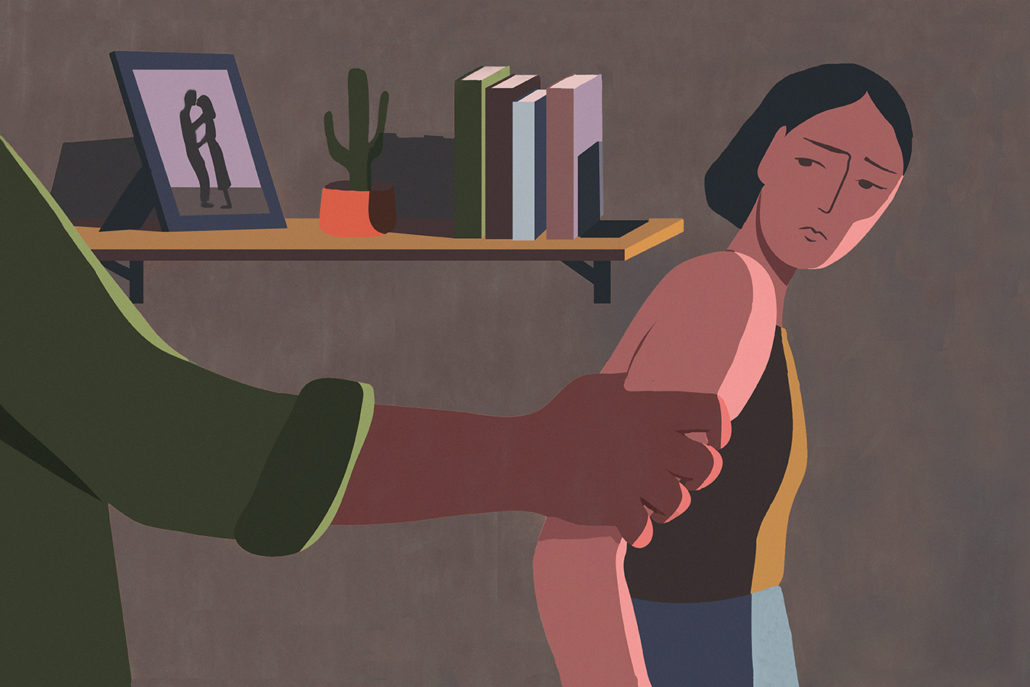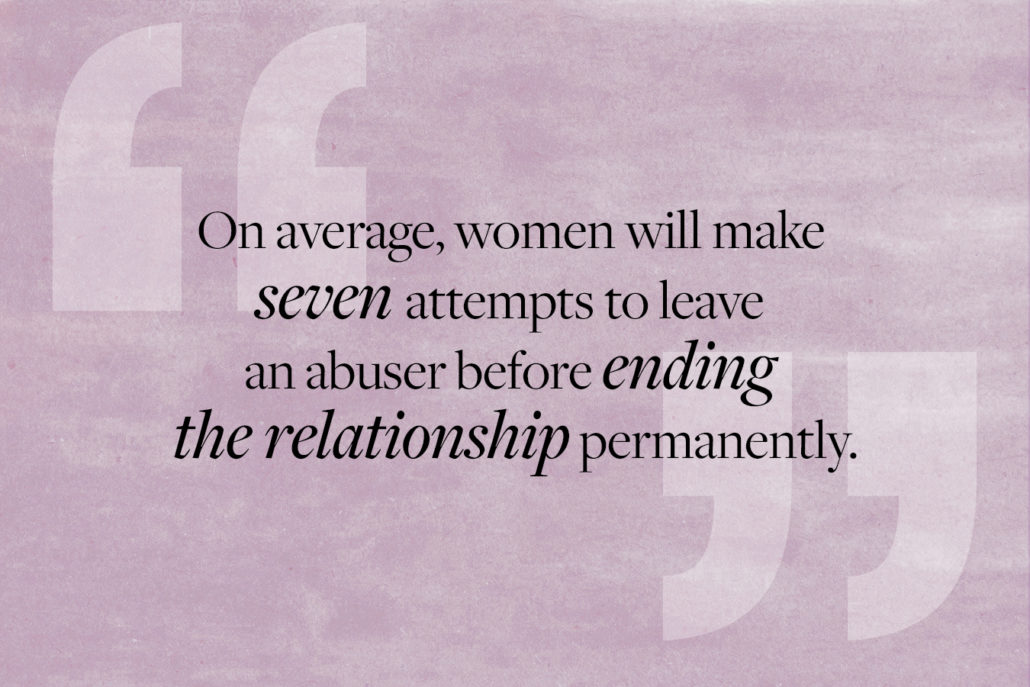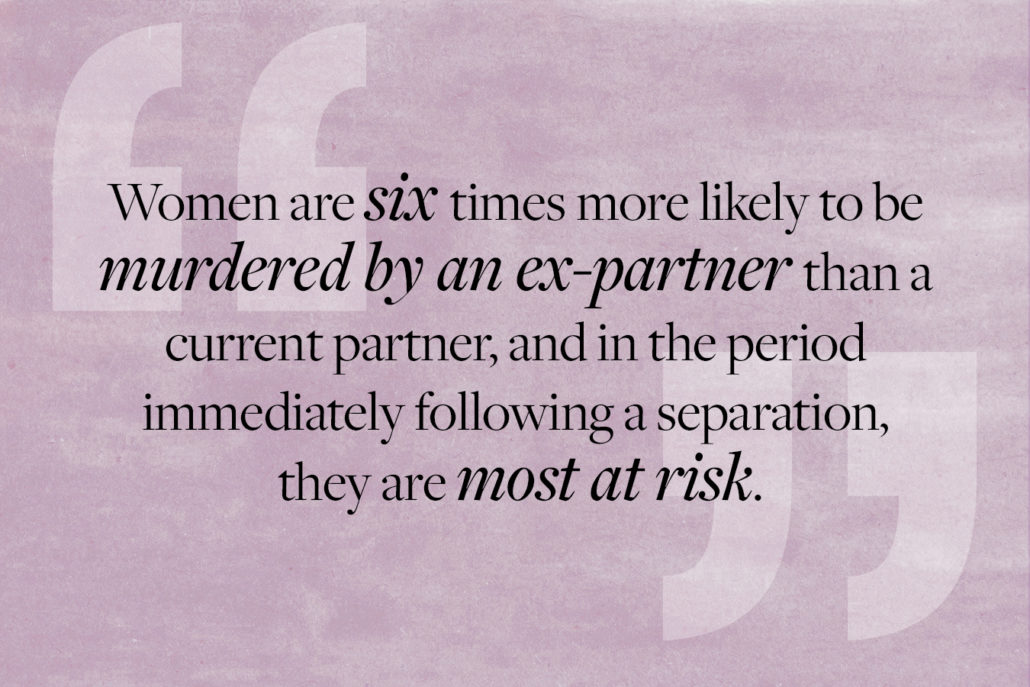
It takes an average of seven attempts to leave an abusive partner. Here’s why
Jen Rollins tried to leave three times before it finally stuck. She spent 14 years with a verbally and financially abusive partner, someone who regularly put her down and directed his anger at Rollins and her two daughters.
The marriage had been a long and arduous road—Rollins’ gut started tingling a few months in, and she knew that the way her partner spoke to her wasn’t particularly nice even back then. But at first there were apologies and promises to do better. After the contrition dried up, there was a steady descent into an increasingly painful status quo.
“You start to think that this is what love looks like—being controlled, being called 50 times when you’re with a friend, and feeling like your partner doesn’t like you,” says Rollins. “You’re in a place where it’s just you and them and the constant tearing down. At some point, I stopped fighting it and allowed it to happen. I knew I had to leave, but I didn’t feel strong enough.”

The patterns of domestic abuse
On average, women will make seven attempts to leave an abuser before ending the relationship permanently. There are so many possible, individual circumstances constraining a woman’s ability to pack a bag and turn her back on abuse that it can be challenging to catalogue in any meaningful way. But there are patterns—patterns of abuse and patterns of reactions to abuse.
It can be painful to watch those patterns replicate seemingly endlessly. When Rollins went to group therapy to deal with the ramifications of living with an abusive partner, she was surprised to hear the same narratives over and over. “I’ve seen my story in hundreds of women,” she says. But more painful is when the very fact of staying, the inability to leave, is used as a cudgel to minimize sometimes-horrific abuse: How bad could it have been, after all, if she didn’t just leave?
“For such a long time, we considered family violence a private matter so there are a lot of misconceptions about what it looks like,” says Sojie Tate, communications manager for Women’s Habitat, a United Way-funded shelter and resource centre in Etobicoke. “Abusers use techniques to control, manipulate and threaten. Violence rarely comes out of nowhere, and typically there’s a slow progression. There’s a process of alienation from friends and families, there’s blaming and shaming, there’s an escalation to threats, and then it’s usually not until a woman is dependent on the relationship that the abuse escalates to violence.”
A startling rise in violence against women in Canada
This conversation has always been pressing, but going by the latest statistics, it has taken on new urgency. Calgary has seen a 40 per cent increase in domestic violence homicides. Amid economic downturns, Alberta and Newfoundland have seen rising rates of intimate-partner violence. And intimate partner violence is still the most common form of violence against women—even in the context of dramatic under-reporting.

The power dynamics of abuse
To an outside observer, abuse might seem like toxic behaviour designed to drive someone away. In fact, the opposite is true. Rather than pushing someone away, abusive behaviour can actually lock an individual in place, destroying the material conditions necessary for independence and also obliterating the self-esteem needed to recognize that a better life is possible.
“The dominant narrative has been men wanting power and control over female partners and that’s part of what’s going on,” says Tod Augusta-Scott, executive director of Bridges Institute, a domestic-violence counselling centre in Nova Scotia. “But these guys also don’t believe that anyone would choose to love them, so they have to force it. If you don’t want her to go anywhere, you don’t have a template for a loving relationship; you have to tear her down to your level. That’s what keeps her from leaving.”
For five years, Rollins wanted to leave. And for five years, she went through the motions of daily life while undertaking a comprehensive analysis of the possible devastation associated with packing a bag and walking out the door.
“He kept telling me that I couldn’t [leave],” she says. “I had two young daughters at the time. Would I be able to stay in my house? Would I be able to make it financially? He told me that he would take the kids, and I would never hear from them again. He had isolated me from most of my friends and family, and he kept telling me that I was alone, and no one would help.”
Victim blaming, gaslighting and self-doubt
It’s extremely common for individuals in an unhealthy relationship to doubt their experience of abuse—either minimizing it or even taking on responsibility for their own mistreatment.
Also common is the perpetrator’s explicit blaming of a victim, often in the form of “If you didn’t do X, I wouldn’t have to do Y.” Rollins says that when you hear that message over and over, you start to believe it.
The risks of violence and revenge after leaving domestic abuse
And then the leaving itself can be dangerous. Women are six times more likely to be murdered by an ex-partner than a current partner, and in the period immediately following a separation, they are most at risk.
In addition to the exhaustive pragmatic concerns a survivor fleeing domestic violence will have to tackle—things like ensuring physical safety, securing a new place to live, finding sustainable work, maintaining custody of children, securing their educational continuity and dealing with family alliances—there are also psychological barriers to grapple with. Even the idea of identifying oneself as a victim can lead to an uncomfortable crisis of identity that mirrors the question sometimes posed by outside observers: What does it say about me that I chose to love someone who treats me this way—and that I stayed this long?

Thinking you can change him
But love can still flourish in the corners of even the most violent partnerships, and survivors are often attached to the affection their abuser meters out. “I had a vision of what my life would be like,” says Rollins. “I would meet the man of my dreams, and we would buy a house and get married and have kids. Part of me just kept trying to get back to that guy at the beginning, the one who was kind and thoughtful and wanted to give me the world. The abuse trickles in and gets worse over time. I can recognize it now as love bombing, but there was a time when he made me feel incredibly loved and safe. We had a house together, and I had invested so much time and energy into my relationship, and I just kept thinking I could fix it and he would change.”
The cultural stigma around divorce
In some communities, these complications can be heightened by stigmas surrounding divorce, domestic violence, and family customs. Humaira Falak spent years in an abusive marriage. After five years, she left, first landing with her two daughters at an emergency shelter. Among the many factors she had to weigh as she contemplated leaving for good were the societal and cultural norms governing her South Asian community. “Stigma is huge, even if you have your family’s support,” says Falak. “There’s a fear of being judged, of raising kids alone and worrying that they’ll be judged, too.”
Falak now works in domestic violence prevention, with the North Star initiative at Action Dignity, in Calgary. She emphasizes the importance of having team members who are reflective of the communities they serve, with whom clients can relate on many levels. Falak herself serves as a very specific example of what many victims face – and the possibility of a positive outcome. As a woman who was living in an unfamiliar country—with no family other than her abuser, no driver’s license, and few material resources. Yet she did manage to move forward with the choice she deemed best for herself and her children. “When I left, there was no one from my community to be non-judgmental and show me that life could be better,” she says. “That’s the difference I try to make now.”
Intimate partner violence in LGBTQ2S couples
For members of the LGBTQ2S community, stigma and broader social marginalization can conspire to create a dual sense of resignation and fear. Studies show that lesbian and bisexual women are at an elevated risk for domestic violence, and yet domestic violence charges are less likely to be made when same-sex partners are involved. “The rejection or lack of resources, particularly for trans folks, from both family and institutions, are big barriers to people asking for help,” says Alex St. John, a therapist for the United Way-funded David Kelley Services LGBTQ+ Counselling program, at Family Service Toronto.
If you’re rejected or estranged from a support network, and there are so few places you can turn to for acceptance or help, then it can be extremely challenging to wrench yourself from a relationship where you once felt like you fit—even if the dream of a healthy partnership is long over. “People constantly tell us that this is the first time they’ve felt like they have a family, so how do you break that up?” says St. John.
A brutal choice: Domestic violence or homelessness?
Planning to leave an abusive partner can require an enormous amount of time and energy—particularly for individuals who are worn down, estranged from friends and family, and accustomed to having someone else exercise control over every aspect of life, from what clothing to wear to how much money they can access. In cities like Toronto and Vancouver, in particular, the cost of living independently can be prohibitively expensive. “The housing crisis is cited over and over by almost every woman as the reason she can’t leave,” says Tate. “She’s making the choice between staying in violence or being homeless.”

Planning to leave an abuser
No matter how clear it may be to an outsider that a person needs to leave an abuser, Tate notes that it’s important not to push. Instead, focus on harm-reduction strategies and safety planning tailored to individual circumstances. “For some women, it might be packing up some belongings and leaving them at a friend’s house or it might be finding a drop-in program or stashing some money away,” says Tate. “It’s about looking at the potential supports you have and how you can tap into them, especially if a situation escalates.”
Several months before Rollins left her partner for good, she started a password-protected note on her phone, where she kept a daily log of the abusive things he said and did. “I made excuses for him all of the time—he’s just tired or stressed out, he doesn’t mean it,” she says. But there, in clear and undeniable text, was a pattern of abuse she found harder and harder to wish away. After planning her departure for months, a sudden burst of violence finally pushed her to end her marriage.
Life after intimate partner violence
Today, seven years after leaving, Rollins describes her life as “amazing.” She moved to B.C. and bought a little house right near the ocean—a place where she and her daughters feel safe. But leaving also required a reorientation that extended far beyond material changes. “It took some time to feel okay after because it does such a big number on you,” she says. “It took a lot of soul searching and therapy to figure out who I was without him and his control.”